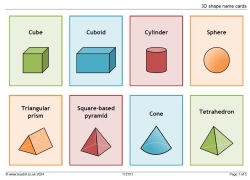3D shape name cards
These editable and printable 3D shape name cards are a handy tool for helping children learn about 3D shapes in KS1 and KS2, from recognising and identifying the shapes to understanding the properties of more complex 3D shapes.
What’s included
- FREE printable 3D shape name cards PDF
- Editable 3D shape name cards including information about each shape
- Editable 3D shape flashcards
How to use these shape name cards in the classroom
In a KS1 classroom, these 3D shape name cards can aid in the introduction and recognition of common 3D shapes. Teachers can use the cards to visually explain the properties of each shape, such as faces, edges, and vertices. The cards can also be used for interactive activities, such as matching shapes to their names or properties.
In a KS2 classroom, the cards can be used to delve deeper into learning about the concepts and properties of 3D shapes. Use the cards to compare and sort shapes based on their properties or to help children understand how shapes can be composed of other shapes. The flashcards included in this resource can be used for additional practice and reinforcement.
How to use these shape name cards for home learning
At home, these cards can be used in a variety of ways to help reinforce understanding of 3D shapes and their properties. Parents can use the cards as a tool to engage their children in learning activities, such as matching the 3D shapes with their names or properties. These activities can make learning fun and interactive, and help children to consolidate their understanding of 3D shapes.
What do children need to know about 3D shapes?
In year 1, children should learn to recognize and name common 3D shapes, understand their properties like faces, edges, and vertices, and start classifying them based on these properties.
In year 2, children should identify and name complex 3D shapes, compare and sort them based on their properties, and understand that shapes can be composed of other shapes.
Later, in KS2, children should be able to describe, draw, recognize, and understand the properties and concepts of 3D shapes.
More resources on 3D shapes
You might also like to try these worksheets and activities for learning about 3D shapes:
3D shapes featured on these cards:
Cube
6 faces
8 vertices
12 edges
Cuboid
6 faces
8 vertices
12 edges
Cylinder
3 faces
no vertices
2 edges
Sphere
1 face
no vertices
Triangular prism
5 faces
6 vertices
9 edges
Square-based pyramid
5 faces
5 vertices
8 edges
Cone
2 faces
no vertices
1 edge
Tetrahedron
4 faces
4 vertices
6 edges

